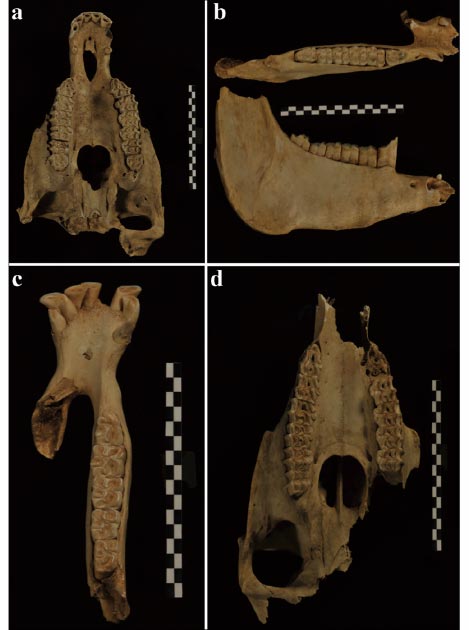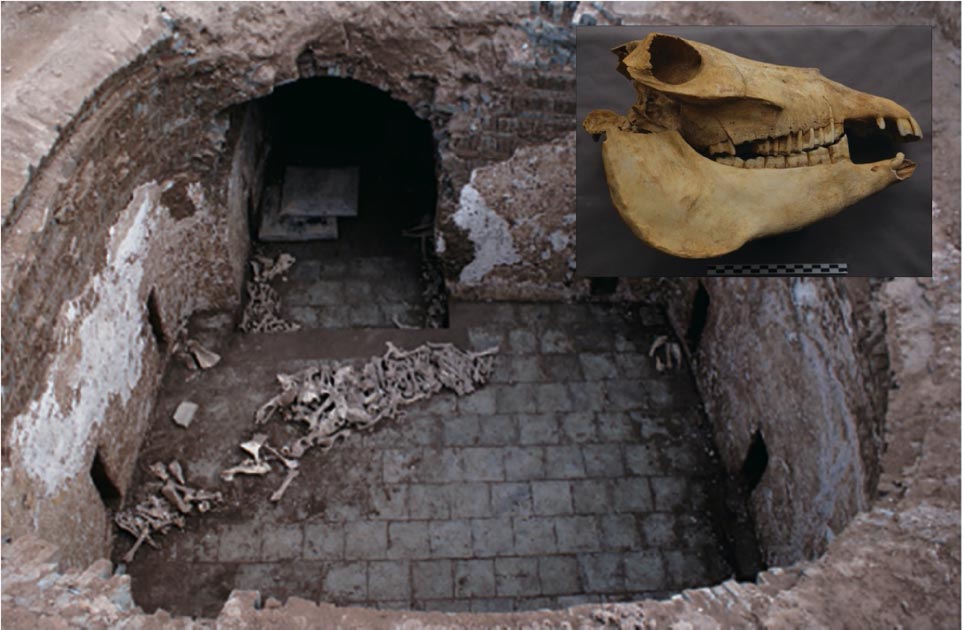Excavation of Elite’s Tomb in China Reveals Sport of Donkey Polo
A new study has revealed for the first time that elite women in ancient China played donkey polo. The remains of donkeys from an elite woman’s tomb indicate that the animal was used for more than transport or traction. These findings have illustrated the unique history of the humble donkey in human civilization.
The remains of a number of animal bones were found in the burial of an elite woman from Tang China in 2012. The burial was near modern Xi’an, which was once Chang’an the capital of the Tang Dynasty, which is regarded as something of a golden age in China. The tomb has been looted but several grave goods were recovered including a stone epitaph, indicating that the person buried there was the noblewoman Cui Shi in 878 AD.

Left: map of the region of China where the tomb was found in Xi’an. Right: The epitaph from the tomb, confirming it is Cui Shi’s. (J. Yang / Antiquity Publications Ltd)
Donkey Remains Buried With the Elite
Professor “Songmei Hu and her zooarchaeological team have identified the animal skeletons in Cui Shi’s tomb as a donkey,” reports Antiquity. The Chinese team was later assisted by Prof Fiona Marshall of Washington University, an expert on donkeys. This is the first time that the remains of this animal have been found in East Asia in a burial.

Animal bones found in the tomb. (J. Yang / Antiquity Publications Ltd)
Prof. Hu from Fudan University and her team carbon-dated the remains and found that they were most likely interred with the noblewoman when she was being buried. Based on Tang mortuary burial practices the donkey was probably buried with Cui Shi to serve her in the afterlife.
However, the question arose as to how the animal could have served the noblewoman in life after death. Professor Marshall in a Q & A with Antiquity stated that “although donkeys were the first pack animal, which took the loads off people’s backs, we know almost nothing about their use in Eastern Asia.”
Ingenious Research Methods
The team of experts then used “multiple analytical approaches to identify and interpret the donkey skeleton found,” reports Antiquity. They used a variety of biometrical techniques on several of the donkey bones. Then they scanned the bones and reconstructed some of the skeletons.

Crania and mandibles of donkey found in the tomb. (S. Hu / Antiquity Publications Ltd)
This was done to understand the “limb loading history” of the animal bones, reports Antiquity. The findings for this were compared with the findings for African wild asses, modern and Bronze Age donkeys.
Prof. Hu and her team found that the donkey bones biometrical results were atypical. They “had unusual locomotion and were well-fed,” according to Antiquity. This implied that they were not used for transport or as pack-animals.
Furthermore, the donkeys were quite small. The Tang government centrally managed the breeding of donkeys and they were bred to be large and sturdy and the bones in the tomb could not come from a beast of burden. Based on this Prof Hu told Antiquity that they had “found evidence of donkeys used for polo and not as burden animals.”

Different shots of the donkey’s humeri. (S. Hu / Antiquity Publications Ltd)
Dangerous Game
To provide further proof for their theory the team referred to the literature from the Tang-era. It is known that the imperial family and the elite “sometimes rode donkeys for the sport of donkey polo,” states Antiquity. This sport was very popular in China after it was imported from Persia. However, it was a very dangerous pastime and an emperor was killed playing it.

a–b) Donkey pottery figurines found in Xi’an; c) sketch of Tang Dynasty Dunhuang paintings (T. Wang / Antiquity Publications Ltd).
Donkeys are smaller and sturdier than horses, and less likely to throw their rider. As a result, they were an alternative to the dangerous game of playing the sport on horses. The find in the burial is proof that elite women played a variant of the equestrian sport. Prof Marshall in an Antiquity press release stated that the evidence “confirms the claims of donkey polo from the literature.”
- The Shang Dynasty: Second in Traditional Historiography, First in Archaeology
- Global Donkey Populations Decimated for Chinese Traditional Medicine
- Donkey milk: Ancient elixir of life experiences modern-day resurgence
First Evidence of Female Polo Players
The literary evidence indicates that Cui Shi was the wife of a governor, who was a noted polo-player. It is believed that he was promoted by the emperor to the rank of general for his polo playing skills. This study provides the first archaeological and empirical evidence that Tang upper-class women played donkey polo, as claimed in the contemporary literature. It also shows that women at this period in Chinese history had a higher degree of personal freedom than in later eras.
Professor Hu in an Antiquity press release stated that “our study broadens our understanding of donkey roles and the relationship between donkeys and humans in the past.” It showed that in East Asia, they were not only used for transport and trade, but also were used for other purposes and demonstrates the importance of equine sport to both men and women in ancient Chinese civilization. The results of Prof Hu and Prof Marshall’s study have been published in Antiquity.
Top image: Main: Cui Shi’s tomb with animal bones revealing evidence of the ancient Chinese nobles playing donkey polo. Inset: A skull of one of Cui Shi’s donkeys. Source: J. Yang & S. Hu / Antiquity Publications Ltd
By Ed Whelan



















